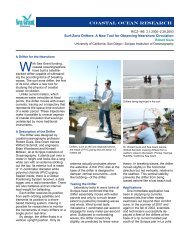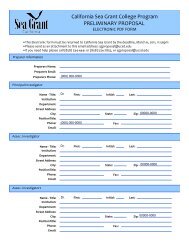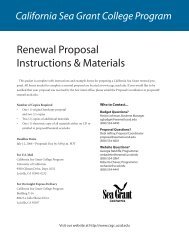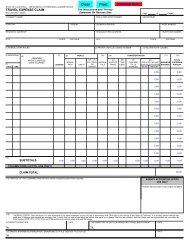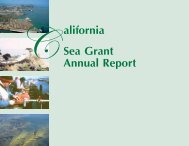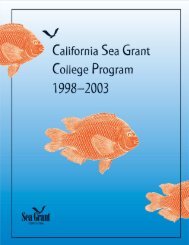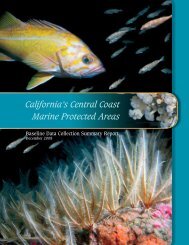Crescent City Profile - California Sea Grant
Crescent City Profile - California Sea Grant
Crescent City Profile - California Sea Grant
- No tags were found...
Create successful ePaper yourself
Turn your PDF publications into a flip-book with our unique Google optimized e-Paper software.
of boats into the early 1980s. However, inrecent years the number of boats and tripsdeclined by 78% and 92% relative to thelong term, while landings, ex-vessel valueand the number of buyers declined by over40%. This decline was largely underwayin the early 1980s, due to the limited entryprogram and highly restrictive regulationsin the Klamath Management Zone (KMZ).Whereas some salmon fishing occurslocally (as regulations permit), localfishermen who choose to participate in thefishery travel to areas with greater fishingopportunities to fish and deliver their catch.• Landings in the pink shrimp trawl fisherypeaked in 1992 at 17.2 million pounds,with an ex-vessel value of $7.8 million.Landings, value, boats, trips and buyersall declined steadily and substantially (by83%–98%) in recent years relative to thelong term due to market, infrastructure andother factors.• A small hook-and-line fishery for rockfishand lingcod accounted on average for 1%–5% of landings and ex-vessel value duringthe period 1981–2007, with an average of23% of boats participating in that fishery.• The coonstripe shrimp fishery, started bylocal fishermen in the early 1990s, remainsa relatively small fishery in terms oflandings, value and fishing effort. Landingspeaked in 2000 at just over 81,000 poundsworth $396,600.Total ex-vessel value (for all fisheries) peakedat $24.7 million in 1988, while landingspeaked at 39.3 million pounds in 1992. In bothcases, the shrimp trawl fishery accounted fora plurality (38% and 44%, respectively) of theactivity. In 2007, 8.2 million pounds worth$12.2 million was landed at the port, with crabaccounting for 81% of landings and 52% ofvalue.The number of boats peaked in 1981, when1,082 boats made 14,494 deliveries, 53% ofwhich were salmon and 25% of which werecrab. Vessel participation was lowest in 2005,when 137 boats made 3,178 deliveries, 3% ofwhich were salmon and 54% of which werecrab. In 2007, 157 boats made deliveries, 67%of which were crab.Of the 20 buyers that received fish at <strong>Crescent</strong><strong>City</strong> in 2007, three accounted for just over 55%of the landed value of the catch, five accountedfor 75% and seven accounted for 90%. The 20buyers include several fishermen who marketat least some of their catch directly to retailersand/or consumers.Average annual prices were lower in recentyears relative to the long term in the shrimptrawl (-33%), whiting (-13%), albacore (-21%),crab (-11%) and shrimp pot (-7%) fisheries, buthigher in the rockfish hook-and-line (+82%),salmon (+13%), and groundfish trawl (+5%)fisheries.The number of ‘<strong>Crescent</strong> <strong>City</strong> boats’ (i.e.,those with a plurality of their ex-vessel revenueat <strong>Crescent</strong> <strong>City</strong>) declined from an averageof 516 per year from 1981 through 1983 to82 from 2005 through 2007, while averagerevenue per boat increased from $37,799 to$141,067. When boats were assigned to theirprimary fishery (the fishery accounting forthe plurality of each vessel’s landed value),this trend was apparent in most fisheries, mostnotably rockfish, salmon and crab. It is notclear, however, how these increases in revenueper boat compare to costs, which also haveincreased over time.<strong>Crescent</strong> <strong>City</strong> Fishing Community <strong>Profile</strong>iii



